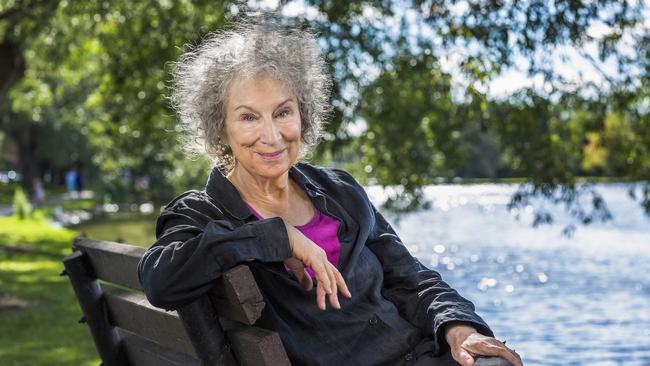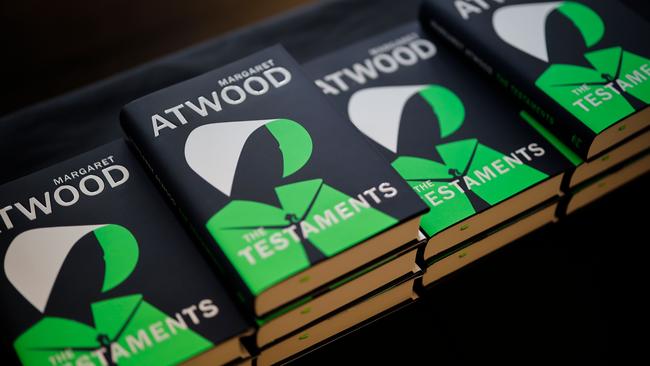Margaret Atwood: Inside the mind of The Handmaid’s Tale author
She’s won just about every literary prize possible and has plenty to say about the state of the world. Now, Margaret Atwood is headed to Brisbane. Read her exclusive interview with Brisbane News ahead of her appearance this month.
Brisbane News
Don't miss out on the headlines from Brisbane News. Followed categories will be added to My News.
Canadian author Margaret Atwood is a literary star. She won’t buy it, but she is. Who else gets a glamorous midnight launch for their new book, The Testaments, at none other than Waterstones Piccadilly in London? She’s the author of more than 50 books, including the dystopian The Handmaid’s Tale (1985), the inspiration behind the TV adaptation starring Elisabeth Moss and Ann Dowd. She’s won just about every literary prize possible, including the Booker Prize for Blind Assassin (2000) and The Testaments (2019). And she’s in Brisbane later this month.

The exceptional cover art for Margaret Atwood’s joint Booker prize-winning The Testaments is a stunning distillation of hope. Created by Noma Bar it is strikingly different to the novel’s forbearer, The Handmaid’s Tale. It is as green as it was red. A sage reminder this might be Gilead, but things are different.
The cover (back and front) features two women, but each woman is also cleverly disguised as a miniature on the other. It is a beautiful image. And bear with me here, if Atwood was a colour it feels fitting she would be that green.

Iridescent and unmistakeable, she is one of the toughest, most loved voices across a spellbinding and remarkably varied platform: novels, short stories, tweets, poetry, essays, children’s stories, fairytales and comics.
And if she were a bird – one of her deepest passions is birdwatching – she might be a blue jay; fiercely intelligent, they are also lovers of shiny things and it doesn’t feel a stretch to imagine that knowledge is one of Atwood’s coveted shiny things.
In her hands it dazzles. It sparkles. She seems to be able to extract just the right quote for the occasion, the most fitting piece of science, often reminding us that what she is doing, what she is talking about is not new – this is history and history does not repeat, it rhymes.
This is a quote, she reminds me when I raise it, that appears at the end of The Testaments. It is followed by another: “Very little in history is inevitable”.

In other words, we have a choice. Something Atwood is strong on. Something that seems to guide her activism, which appears to be increasing. Perhaps it is age. She turned 80 last November.
“I won’t be here. That’s your problem not mine. What are you doing about it?, she asks a lot, while deftly steering our conversation towards conservation.
And she means it. Kill the oceans and you are dead, she says. Anything that relies on oxygen doesn’t stand a chance.
She wields her knowledge about the human impacts on the planet with aplomb, like a baton against our most treacherous abuses. She is fighting to save our natural world, before it’s too late. “I won’t be here,” she says again. “But you will be.”
The collective you. The you that also includes the stormfront that is teenage climate change activist Greta Thunberg and Extinction Rebellion (XR), the latter a grassroots movement that has riled politicians at every level in this country.
Atwood refers to both often because they give her hope.
On hearing that Brisbane has banned XR from meeting in its public libraries and tough new Queensland legislation that threatens the sanctity of peaceful protest, she says “that is the first step towards a totalitarian government”.

“Unless you have free speech and unless you have the right to peacefully protest you have an authoritarian government and you are one step away from totalitarianism. So why do they think these people are so dangerous?”
“To whom are they dangerous? What sort of society are they dangerous to? I would say it is pretty dangerous to society if you are on a collision course with total human extinction. And who is on that council and when is the next election?”
I tell her the Brisbane City Council elections are next month.
“Oh boy, well you know, legislate your own extinction if you like, I won’t be there.”
And furthermore, she wants to know, “Why isn’t the ban on Extinction Rebellion unconstitutional?”.

Atwood will be in Brisbane later this month, Feb 22, as part of her international tourIn Conversation with Margaret Atwood which has seen her engage audiences in the UK, Ireland, New Zealand and, from Sunday, across Australia. She loves Australia.
She was here in February last year with her husband Graeme Gibson, the Canadian conservationist, activist and writer who died in September last year.
Gibson’s mother was Australian, she grew up in Brisbane, and Gibson and Atwood regularly spent time with his cousins and their extended family, most recently on that 2019 trip. She will see them all again this month.
RELATED READS
Sri defends climate vigilantes, will close office to strike
She calls from New Zealand.
Her voice is steady and sure, like a wave rolling in. You can feel the weight of it but then when she laughs it is contagious because afterall, Atwood is incredibly funny. One of her more recent works Hag-Seed (2016), a re-imagining of Shakespeare’s Tempest, part of the Hogarth Shakespeare series, is as raucously funny and mischievous as it is tragic and remarkable.
We laugh momentarily about an earlier Tweet of her riding a scooter in a windy Wellington carpark.
It reads: “I shouldn’t have, but I did. That’s Alex @FaneProductions killing himself laughing. I didn’t run over anyone (thistime). #wellington. NZ: filled with temptations.”
Of the following thread, in which someone offers her rollerblades for her Galway 2020 visit, she says: “I haven’t committed to that. I don’t think they want to be responsible for my concussion.”
I shouldn’t have, but I did. That’s Alex @FaneProductions killing himself laughing. I didn’t run over anyone (this time). #wellington N Z: filled with temptations! pic.twitter.com/WJynbkG28X
— Margaret E. Atwood (@MargaretAtwood) February 9, 2020
She loves Twitter, having joined in 2009. She tweets about everything from climate science and bird tales to recycling tips and stories of brave women. She tweets about just finishing My Year of Rest and Relaxation by Ottessa Moshfegh, calling it a “caustic, funny, dark addition to the lineage of unlikely female protagonists” by authors like Sheila Heti, Emily Bronte and “grandmamas” Lady Macbeth and Medea.
Twitter, after all, is just another way of sharing stories and Atwood has been a storyteller forever. She once told a journalist she had wanted to be a ballerina when she grew up, but later admitted it wasn’t true. But she did want to be a fashion designer. And an artist.
The collision of the two may well be in one of her more recent literary adventures – the graphic novel series Angel Catbird about a genetic engineer caught in the middle of a chemical accident who discovers he has superhuman abilities. It’s a superhero comic-style book, and Atwood has always loved comics. She made her own as a child and says her notebooks were filled with flying cats and angels as well as dresses.
What else was a child living in the sometimes terrifying woods in northern Ontario supposed to do with their time except slip into the wilds of their imagination?
It’s a place she has drawn on since she wrote her first real poem as a 16-year-old. The moment sealed her intention to be a writer.
On just on her writing – please indulge my to return to blue jays, about whom Atwood has written quite often. They are mimics. The best. And while copying is not exactly what Atwood does, she does borrow and reflect history’s darkest moments (the rise of the Third Reich, global denial on climate change) or its greatest triumphs (Joan of Arc, the French Resistance, Greta Thunberg) and turn them into undeniably gripping tales with protagonists (not Thunberg yet) whose lives go well beyond the page and wind up symbols of resistance, AKA The Handmaid’s Tale protests around the globe.
Silent, stunning, profound.
The Testaments, the gripping follow-up to The Handmaid’s Tale, is here largely because readers kept asking what happened. What happened to central character Offred, a handmaid in the Republic of Gilead, a totalitarian state where handmaids are forced to bear children for barren couples.
It took 35 years for Atwood to tell us, but now we know.
We also know from Atwood’s work that survival hinges on defining moments. She says we are in the midst of it now and the problem is that government is not listening to the science. “I would really like to know why politicians think they [young environmental activists] are so dangerous and by the way, pretty soon they are going to be able to vote. They are not going to vote for you.”
Atwood historically reserves her emotions for blistering take-downs, fuelled with facts and a lifetime of watching human beings.
She means it when she says, in an almost accusatory tone, “If you were smart at all you would start taking advantage of Australia’s natural resources, one of which is a lot of sunlight.
“So why aren’t you doing that. You could have a flourishing green economy. Why not? You have a lot of miles of continental shelf. They’ve done the math and if there were offshore wind farms on continental shelves that would supply all the electricity needs. Why aren’t you exploiting that, why aren’t you exploiting all your sunlight of which you have a lot?”
We touch on religion, a cornerstone of the Gilead stories, in response to a Tweet about a religious group called Sojourners and whether or not religious thinking contributes to the human sensibility that we have dominion over the planet.

“We are part of nature, every time you breathe in you are breathing in something that nature made,” Atwood says.
“You’ll notice that the thing I retweeted is from a religious group called Sojourners? And they are a green religious organisation and there are a number of those. There’s one called Arocha and I support them. So there’s something called the Green Bible in which all the environmental bits are printed in green. It’s made of responsible paper and it’s got a nice linen cover.
“So, there is this other area of religion and all religions have it. There are green Judaic parts of that, green Muslim, green Hindu parts – there are green Buddhist parts. It’s not a question of blaming religion. Religion on the other hand could be the solution if it decided to be so.
“And there are these elements already who are turning this way because they get the connection. You can’t actually proclaim your love for humanity and brotherhood unless you are thinking about how people really live and what they breathe and eat.”
How we breathe and eat is very much on Atwood’s mind.
When she tours here she is going to visit the bushfire ravaged regions of southern Australia with Bird Life Australia, with whom Atwood and her late husband Graeme have a long affiliation.
Being part of these things gives her hope.
“The activities of young people such as Extinction Rebellion are very encouraging because it shows that segment of the population understands the connection. But it’s not only young people. There’s a lot of older people.
“This has been a theme since at least the 1950s. It’s just that people weren’t paying attention earlier. It is young people but it is a lot of other people as well.”
And older she may be but one hopes Atwood will mark many, many more years telling us stories that drive us to ask what happened and why?
In Conversation with Margaret Atwood, Feb 22, Concert Hall, QPAC, from $69


